Walter Crane (3)
misajour 2012/03/20
28 janvier 2012 00:37 0 messages
Troisième épisode de mes notes de lecture de "An artist’s reminiscences" par Walter Crane ; pour les deux précédents, voir :
![]() épisode 1
épisode 1
![]() épisode 2
épisode 2
et pour le suivant
![]() épisode 4
épisode 4
Si, comme nous venons de le lire, Walter Crane avait laissé déborder en vers ses élans lyriques, c’était certes le paysage qui l’inspirait, mais aussi une rencontre, celle de sa future épouse.
... Certain sonnets of D.G.Rossetti’s appeared in the Fortnightly, I shall never forget the impression they created. I had essayed the Shakespearian form of sonnet, but these at once instigated me to try my hand at the Italian kind of construction.
In my own feeling I found sufficient excuse, as about this time I had met the lady who aftewards became my wife.
She spent the winter of 1868-69 with her family in Tavistock Square, and for long a certain corner house became a center of the deepest interest, and Bloomsbury a realm of romance.
With her brother and sisters, however, she departed on a travelling expedition, and we did not meet again till 1870. Under these circumstances I sought what solace I could in inscribing sonnets to the absent beloved one, in the intervals of my ordinary work.
L’année la plus longue, celle de l’attente d’une épouse
Bien qu’il parle a posteriori en termes enflammés des événements européens de 1870-71, du siège de Paris, de la Commune, de la chute de la papauté en Italie et du règne de Victor-Emmanuel, il reconnaît que ses préoccupations du moment étaient ailleurs :
Though as I have indicated, by no means without political feeling and sympathies, my real world was a dream-world, a cloister, or quiet green garden, where one only heard afar and dimly the echoes of the strife of the great world.
In this mental retreat one really lived and worked at that time, and more and more so when one’s whole being became coloured and fused with the despest and most vital of all human feelings — love.
In such a mood I first read Rossetti’s sonnets and The Earthly Paradise of William Morris, which was first published in 1870. To read the latter seemed like entering one of the delightful houses or halls the poet himself helped to create and often described, stone-pillared, open-timbered, and hung with arras tapestries full of mythical histories and legends of races, and glowing in gold and colour.
On retrouve le même lyrisme dans ses descriptions de paysage, par exemple pendant un séjour à Btews-y-Coed en pays de Galles avec d’autres peintres paysagistes ; l’ascension du Mont Snowdon lui inspire ces quelques lignes :
We reached the summit near sunset, passing through a field of cloud, which when we emerged looked like a great sea of rolling billows breaking at our feet, the sun shining out across them before he sank.
La rencontre de Morris et Burne-Jones à qui il rend visite à "La Grange" est décisive au niveau intellectuel et artistique et comme il l’analyse avec beaucoup de perspicacité :
The success of the type of art associated with the name of William Morris and his coadjutors was no doubt due — apart from the effect of his own powerful personality and initiative — to the practival nature of the experiment in the actual revival of certain handicrafts, as well as the co-operative nature of the entreprise, uniting, as it did, in the persons of the artists concerned in it, architecture cabinet-work, decorative design and painting, metal-work, pottery and tile-making, and stained glass."
Il se souvient encore, avec précision, des décennies plus tard, des tableaux exposés par Burne-Jones dans son studio :
He was then surrounded with a vast quantity of work ; and pictures and designs in every stage nearly were to be seen in his studio, the more finished being hung in the anterooms.
I remembered the design of "Fortune" in monochrome, several of the large subjects of the Perseus series, and "The Sleeping Beauty", the unusual "Pan and Psyche", "The Feast of Peleus", "Venus’s Mirror" and "The Days of Creation", and a fine series of pencil designs illustrating Virgil’s "Aeneids" which were, I believe, originally intended to accompany Morris’s translation.
The sight of so much interesting imaginative work was very inspiring, and no doubt one fell much under its influence for some time.
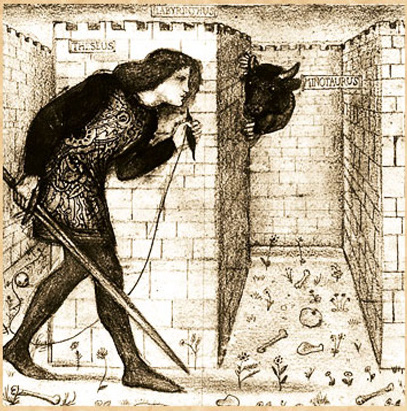
Mais il se souvient aussi d’autres rencontres, celle du dessinateur français installé à Londres, Alphonse Legros par exemple :
I must have met M. Legros about this time at Palace Green. The fine draughtsmanship, grave, reserved, rather Holbeinesque treatment of Legros’ portraits and figure subjects commanded my admiration. I always regretted that my deficiencies in the French tongue have been obstacles in the progress of my acquaintance with this distinguished artist, and prevented much intercommunication between us.
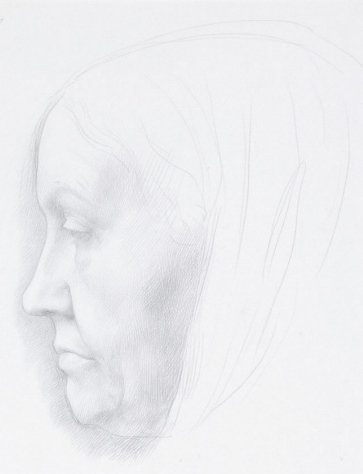
J’aime beaucoup également sa phrase concernant Courbet :
Other distinguished foreign artists came to London after the downfall of the brilliant short-lived Commune, and it is noteworthy to recall that such artists as Courbet were associated with this great effort to establish a true collective civic Government in the interest of the workers both of hands and brains, rather than money lords.
Une rencontre décisive, celle de l’art japonais de l’estampe
En ce qui concerne la littérature enfantine, il prend le rythme de publier environ deux livres par an avec Edmund Evans :
About 1869-70 they began to show something like a distinct decorative treatment and style, as I endeavoured to adapt them more both to the conceptions of children and to the conditions of colour-printing.
In this I found no little help and suggestive stimulus in the study of certain Japanese colour prints, which a lieutenant in the Navy I met at Rode Hall, who had recently visited Japan in his ship, presented me with.
Their treatment in definite black outline and flat brilliant as well as delicate colours, vivid dramatic and decorative feeling struck me at once, and I endeavoured to apply these methods to the modern fanciful and humorous subjects of children’s toy-books and to the methods of wood-engraving and machine-printing.
"The Fairy Ship", "This Little Pig went to Market", designed in 1869, and "King Luckieboy’s Party" (the verses and idea of which were supplied by me), in 1870, made this new departure, and led on to their successors, which shortly became numerous enough to be put in a separate category and labelled with my name by Messrs. Routledge.
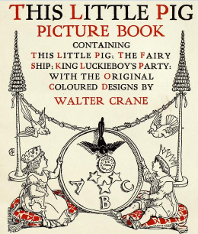 |
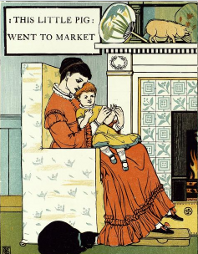 |
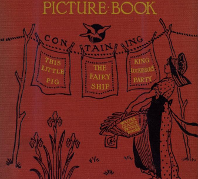 |
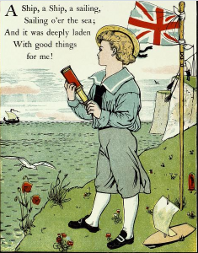 |
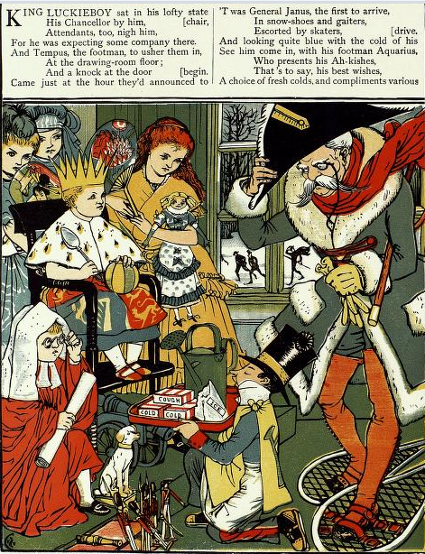
KING LUCKIEBOY sat in his lofty state chair,
His Chancellor by him,
Attendants, too, nigh him,
For he was expecting some company there.
And Tempus, the footman, to usher them in,
At the drawing-room floor ;
And a knock at the door
Came just at the hour they’d announced to begin.
’Twas General Janus, the first to arrive,
In snow-shoes and gaiters,
Escorted by skaters,
And looking quite blue with the cold of his drive.
See him come in, with his footman Aquarius,
Who presents his Ah-kishes,
That’s to say, his best wishes,
A choice of fresh colds, and compliments various.
At last, actually engaged
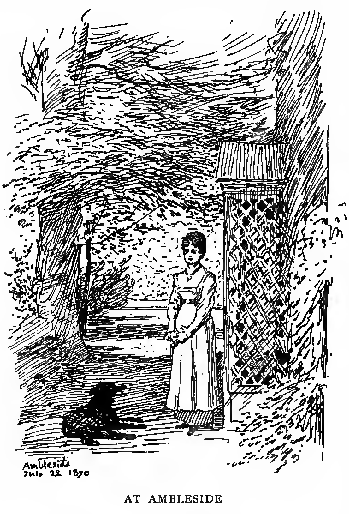
The year flew by marked by delightful and never-to-be-forgotten visits, first to Oxford, in early summer, which seemed an ideal dream-city such as one might see painted in a mediaeval missel, echoing to the sound of sweet-voiced choirs in its solemn college chapels, or the song of birds in its tree-shaded walks, and green and golden meadows bordered by the silvery waters of the Thames or the Cherwell.
Later in the summer I joined my affianced at Ambleside... The spirit of Wordsworth and the Lake poets still seemed to haunt the wild mountain paths and rocky dells...
Leur séjour à Hempstead dans l’Essex pendant l’été 1871 est l’occasion de décrire en détail l’architecture rurale locale, les vestiges historiques d’une motte féodale,
Wynchlow Hall...only one wing remained of the old part, which had probably been surrounded by a moat, a relic of which formed a considerable pond at the edge of the lawn, gay that June-tide with yellow flags.
et un spectacle inattendu sous la plume de Walter Crane, la tonte des moutons :
An interesting sight was the sheep-shearing in the great barn. The big doors were taken off their hinges and laid flat, and on this improvised platform the shearers did their work.
There were three of them, and it was noteworthy to see the skill with which they handled both the sheep and the shears, getting the heavy fleeces off with the greatest neatness and despatch, the sheep for the mort part being very passive in their hands, and certainly "before the shearers — dumb."
Deux années en Italie
Le voyage de noces en Europe et le long séjour "en résidence" en Italie ne lui font pas perdre son sens de l’humour ; voici quelques croquis romains de 1872,
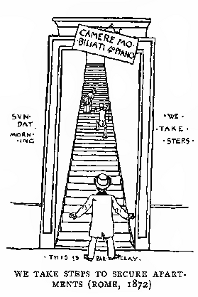 |
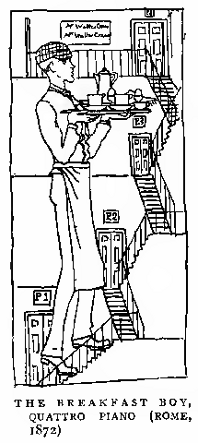 |
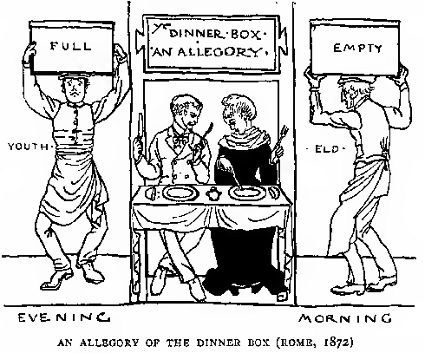
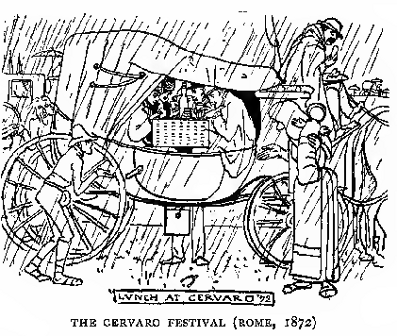
puis de l’année suivante et du retour "home" !
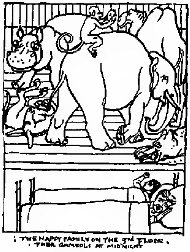 |
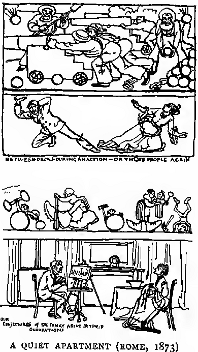 |
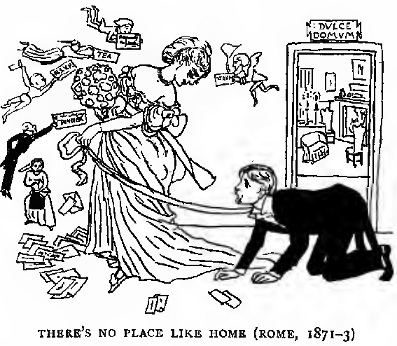
Le dernier hiver à Rome, une fois trouvé un appartement un peu moins bruyant, fut consacré au dessin :
I was able to carry on my work in the sitting-room, the windows of which looked towards the north. Several of the early series of children’s picture-books were designed here — "Mother Hubbarb", for instance, whose famous dog I took the liberty of depicting as a poodle, that type flourishing at that time in Rome.
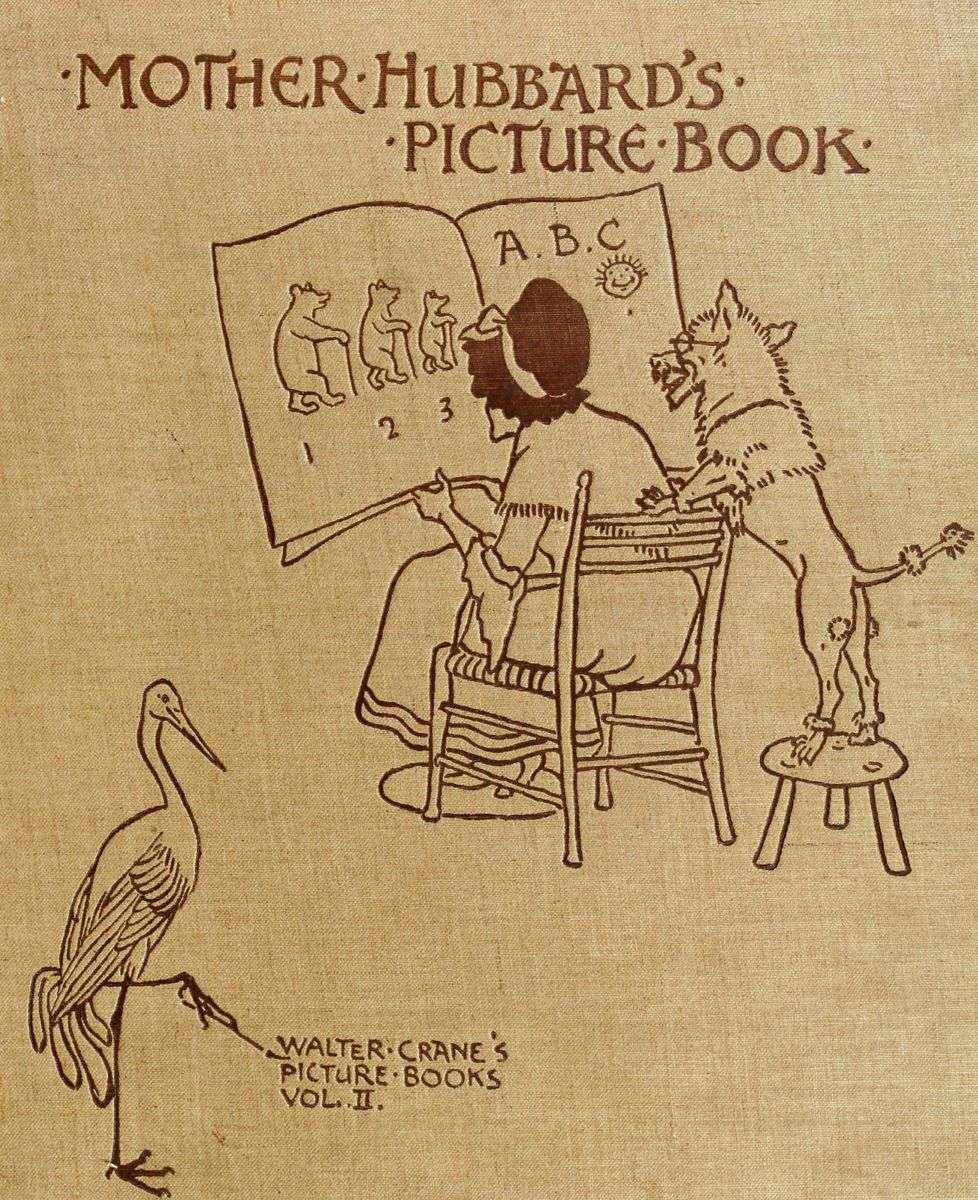
The drawings were made on card in black and white and sent to London through the post to Mr. Evans, who had them photographed on to the wood and engraved, returning me the proofs to colour.
This method of working now beginning to supersede the old practice of drawing direct on the block for the engraver. It certainly had its advantages, not the least among which was that of being able to retain the original drawings.
Drawing for publishers was varied by making water-colour studies out of doors, or finished drawings to send home to London exhibitions.
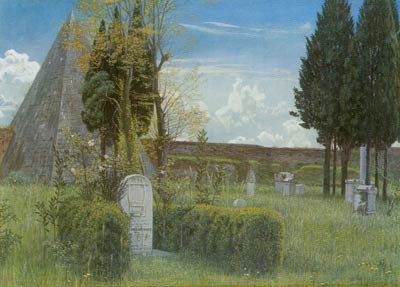
The Protestant Cemetery in Rome, 1873 : Keats’ gravestone in foreground.
Dans la même rubrique
7 janvier 2019 – Rose de l’an neuf
26 novembre 2018 – Gustave Doré in London in 1872
19 novembre 2018 – Marie-Madeleine Dauphin
20 janvier 2017 – Énigme policière dans la Ferme des Animaux
6 août 2016 – La Joie de vivre





